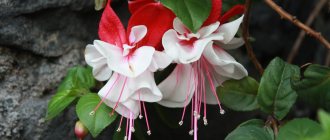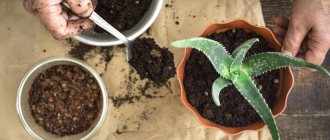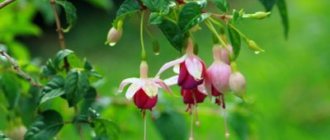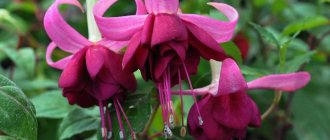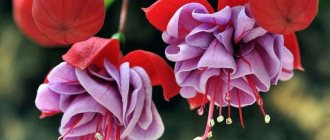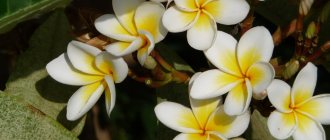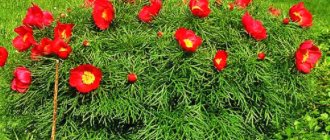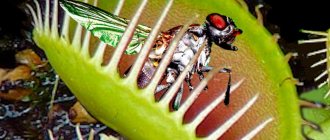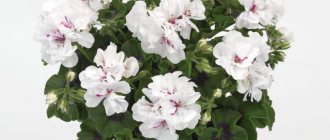It is rare that anyone can pass indifferently past a delicate, graceful plant, “crying” with teardrop flowers of various shades. Thin leaves, exquisite, very unusual flowers, beautiful colors - this is fuchsia. Nowadays it can rarely be found in the collections of flower growers, although previously there was no house in which the hostess would not proudly lead guests to the blooming beauty.
Although, recently interest in fuchsias has begun to awaken. First, the first, timid collections appeared, then the army of fuchsia growers began to grow and get stronger. Selection, propagation, breeding and import of new beautiful varieties from abroad has turned into an interesting hobby, very entertaining and infectious.
Description
There are several stories of “recognition” of a wonderful plant. The first one is somewhat fantasy. On the shores of the Strait of Magellan, a delicate plant has existed for a long time. For local residents everywhere, the growing Thilko was more than familiar. But George Handisid had never seen such beauty before and brought it home. However, the herbarium of the London History Museum has already been decorated with several specimens of fuchsia. This is the second, official version.
A priest and adherent of treatment with medicinal plants, Charles Plumier, in search of a cure for malaria in the foothills of South American Santa Domingo, found a delicate plant with scarlet flowers of an unusual, amazing shape. The found flower received a complex name - TriphyllaFlora Coccinea, which was later somewhat reduced to Fuchsia triphilla, immortalizing in its name the name of L. Fuchs, a German doctor and biologist. According to this version, the year of birth of fuchsia is 1703, it was then that information about the miraculous discovery was published.
The living flower came to England much later - in 1789. Crosses between F. coccinea and Fuchsia Magellanica resulted in the first recorded cultivars, such as Globosa. The variety had red-violet, fairly standard flowers, but even later, researchers and amateurs began to bring more and more new species. Searches in Peru, Mexico, Chile, and Ecuador were crowned with success, the number of varieties increased, and the diversity of the plant began to attract more and more attention from flower growers.
The first variety with snow-white flowering “Venus Victrix” and with double flowers “Duplex and Multiplex” revolutionized fuchsia growing, the plant began to conquer the world.
Fuchsia - a medicinal plant
As a truly medicinal plant, fuchsia, of course, is not used. However, the opinion about its magical, aura-improving, healing properties is firmly among the people. Fuchsia is credited with a number of positive qualities.
Magical properties of fuchsia:
- development of intuition, creativity;
- increased mental and physical activity;
- reducing the risk of exacerbation of chronic and occurrence of acute forms of various diseases (gallbladder, gastrointestinal tract);
Fuchsia in cooking
Surprisingly, fuchsia fruits can be eaten. Moreover, it tastes very interesting – tart and peachy. A skilled housewife makes excellent fillings for pies, jam, even wine and liqueurs from the fruits.
Signs and superstitions
The existing legend gives the plant a particularly mysterious flair and fabulousness. Legend says that fuchsia flowers are nothing more than seven beautiful sisters who fell asleep forever in a whirlwind of a fast dance. Witchcraft destroyed the dancers for not wanting to be in captivity, but now collectors of the most beautiful flower can forever admire this dance.
Poor fuchsia suddenly received another, not very pleasant name: “widow’s tears.”
The existing belief says that the plant “survives” the men at home, but despite this, thousands of happy families watch the extraordinary flowering of this wonderful bush.
Botanical description
Fuchsia is a small tree or shrub. On the flexible branches there are oval leaves, pointed at the end, located oppositely. The bush has the ability to bloom very lushly and for a long time.
The flower is of particular interest. A tubular corolla with bent leaves is surrounded by a bright calyx. The long stamens that look outwards greatly decorate the flower. For this form, the plant was popularly given another interesting name: “gypsy earrings.”
Varieties and types
Ampelnaya
Ampel fuchsia is not a separate variety, it is rather a variety of plant, the structure of which includes various subspecies and varieties. A special feature is the ability of flexible stems to droop, forming a beautiful lush cap, literally dotted with flowers.
Holly's Beauty
One of the famous varieties of ampelous fuchsias is Holly's Beauty, bred in England in 1989. Holly's Beauty is an amazing variety. Quite long graceful buds open into bluish-white double flowers, decorated with thin white threads-stamens. The plant takes root very well.
Blue satin
Blue satin
Also an ampelous form. Very flexible drooping branches, entirely covered with greenish leaves with a red tint. An unusually large flower with a soft purple skirt is complemented by pink sepals with white-greenish tips. To be decorative, the bush must be shaped; in the spring, the plant requires good pruning. With proper feeding, it responds with powerful flowering.
Blue angel
Blue angel
Low, up to 30-45 cm, semi-ampelic fuchsia with very large double flowers. In addition to flowers, the variety is decorated with dark green, slightly jagged leaves and elongated beautiful buds.
The color of the sepals is white, the tips are greenish. The pink coating of the skirt emphasizes the subtle blue of the petals. The scalloped edges give the flower an airy feel.
Cuttings are very easy to root; in suitable conditions the plant overwinters well.
Annabel
Annabel
One of the white princesses in the kingdom of fuchsias. It amazes, especially beginners, with its “porcelain”, fragile-looking flowers. The snow-white skirt bashfully exposes the pinkish stamens, the wreath of slightly pinkish sepals is almost a crown. The leaves are a delicate light green color at first; as they mature, the leaf blade darkens.
An important condition for preserving the decorative effect of flowers is to avoid direct sunlight.
The plant is obedient to formation - right up to the standard. The advantage of this variety is its active growth and early flowering.
Bella Rosella
Bella Rosella
The variety is unique in its versatility. Very fast growth with a powerful growth of non-fragile shoots allows you to form a plant, both in the form of a standard and in an ampelous form.
Very large flowers, with an intense pink, even purple, skirt and a delicate white-pink “crown” of sepals turn a “tree” or a lush bush into lacy foam. The flower is worthy of becoming an adornment of the most exquisite collection.
Royal mosaic
Royal mosaic
One of the most common and favorite varieties of fuchsias. Very large, “fluffy” (double) flowers are original in color and shape. The blue-violet skirt, rich in tone, is set off by pink “strokes-splashes”. The sepals are white on top and, when fully opened, show a pink underside, which looks very decorative, especially in combination with rounded large white buds. The background is also beautiful - slightly jagged, bright shades of green leaves.
It blooms luxuriantly and grows intensively - a wonderful variety in all respects, both for amateurs and professionals.
New Millennium
New Millennium
This is an amazing, very original and unusual variety. Bushy, beautifully and quickly branching, fuchsia lends itself well to shaping. But the view of a flowering plant is especially good. On a light green background of thin leaves, surrounded by large lilac buds, double flowers of unusual colors bloom.
The dark red (to black) skirt becomes cherry at the end of flowering, but seems to glow from the inside.
The red sepals add a glow and wonderfully frame the center of the flower with its long, graceful stamens.
Voodoo (voodoo)
Voodoo (voodoo)
It is distinguished by its unusually beautiful colors, contrasting and very bright. The dark purple skirt surrounded by intense red sepals and heart-shaped buds immediately attracts attention. The remaining qualities are also good - power and speed of growth, abundant flowering, easy formation. The variety is suitable for beginner gardeners.
La campanella
La campanella
A small-flowered but profusely flowering variety, usually grown in a hanging form. White sepals above a lilac skirt look like lavender mist enveloping a lush bush.
How to care for fuchsia at home?
Fuchsia, in general, is not a demanding plant and is quite grateful for care at home. In city apartments, if a number of conditions are met, it can be grown very easily, achieving good flowering and excellent decorativeness.
The soil
For fuchsias, light, loose and very nutritious (due to constant, intensive growth) soil is best suited. A mixture of peat, humus, compost and sand is suitable. A small addition of superphosphate (about 0.5%) and ash (about 1-3%) will provide the plant with nutrition.
It is necessary to put drainage at the bottom of the container, since fuchsia roots suffer greatly from stagnant moisture.
Light
Despite the opinion that fuchsias are shade-loving flowers, the plant still loves light. The only thing is that direct sunlight should not be allowed. The shades of flowers suffer from sunlight and the leaves turn yellow. Blinds will perfectly protect you from excessive lighting, and fuchsias feel best on eastern and western windows and balconies.
Watering
The plant really does not like excess moisture. A flooded fuchsia drops its leaves and dies very quickly; it is practically impossible to restore.
Proper watering includes:
- checking the ground. It should become almost dry, but for a very short time. Overdrying the soil is also detrimental to fuchsia;
- checking pallets. Under no circumstances, even in hot weather, should water stagnate in the pan;
- shower device. There is an opinion that fuchsia is a “rainy plant”. It's not entirely true, but the flower loves showers. The plant will respond to moderate spraying with lukewarm water with elastic greenery and lush flowering;
- selection of water for irrigation. Water for irrigation should be at room temperature or slightly lukewarm, settled.
Feeding
Fuchsia loves feeding very much. According to experts, it is necessary to feed the plant according to the principle “often, little by little.”
A weekly application of fertilizer suitable for the period (stage) of flower development is quite sufficient.
Plants during periods of intensive growth, especially young ones just beginning to grow, need nitrogen. Complex, specialized formulations, such as Planta, are suitable.
At the beginning of flowering, it is very good to feed with phosphorus and potassium. Complexes for flowering plants (“Kemira”) are rich in it.
Features of breeding fuchsia
The plant looks very attractive during the flowering period. The shade of the flower depends on the variety, and how abundantly the flowering itself occurs depends on proper care.
Flower growers practice 3 methods of propagation:
- seeds;
- leaf;
- cuttings.
The first and second methods are quite time-consuming and do not have a guaranteed result. Propagation by cuttings is usually simple; they take root easily and begin to grow.
Growing fuchsia for decorative purposes has a history of more than 250 years.
Several cuttings can be cut from an adult plant without damage.
How to trim and pinch fuchsia?
Pruning and pinching fuchsias is a necessary technique to increase the intensity of flowering. Thanks to these operations, the number of shoots bearing buds increases.
Pinching the cuttings
A young plant is usually pinched three times, each time removing the growing points of new shoots. The first time, pinch out one existing shoot. The second time - the growth points of two newly formed cuttings are pinched again (there are already two of them). And the third time, having cut off all the growing points, they get a fairly fluffy bush with many shoots formed.
Duplicate pinching
The method allows you to form a plant very quickly. New shoots are pinched without waiting for the internodes to grow. This method of formation must be done carefully, since the mass of branches formed is very large.
You can pinch the plant at any time of the year, the only condition is that the formation must be stopped two months before the expected flowering.
How to form a standard fuchsia?
A real tall tree (up to 1 meter in height) can only be obtained in natural conditions or in special greenhouses, since the trunk needs good and, most importantly, uniform lighting. In an apartment, this interesting activity will also lead to results, but the tree will be small.
To form a trunk you need:
- choose a suitable cutting. It should be strong, rooted, and, preferably, upright;
- tie the cutting to a high peg;
- feed with fertilizers containing mainly nitrogen. Further, during formation, it is necessary to use only such fertilizers;
- place the cutting in the light;
- as they grow, remove all buds and shoots (lateral);
- after waiting for the required height (about 1 year), pinch the top;
- Then pinch the resulting crown according to the usual rules.
When forming a trunk in a city apartment, fuchsia must be turned towards the light so that the crown is uniform.
How to propagate fuchsia?
Cuttings
The best and fastest way to propagate fuchsias at home is by rooting cuttings. You can take any cuttings, even the tops remaining after the formation. But best suited, especially for beginners, are mature shoots 9-12 cm long, with two or three pairs of leaves.
Progress
1) Prepare:
- containers with water or soaked peat tablets placed in cups;
- cuttings with lower leaves removed;
- plastic bags or cans (for the “greenhouse”);
- artificial lighting (this is especially true in winter).
2) Place the prepared cuttings in a container with water or insert into a tablet.
3) Place on pallets, cover with a bag (or jars), and place in a warm place.
4) Organize lighting. Rooting of cuttings occurs in the second or third week.
Seeds
The seeds extracted from the fruit must be dried. After two or three days, sow the dried seeds on a light nutrient substrate, cover them with glass or film (they cannot be embedded in the ground). Place the sown substrate in a warm, illuminated place.
After two to three weeks, when the seeds have sprouted, make the greenhouse higher, but it is not recommended to open it completely. Seedlings that are one and a half to two months old should be planted a little further from each other. Gradually accustom the grown seedlings to the open air, opening the greenhouse slightly.
How to plant - cuttings or seeds?
Fuchsia reproduces vegetatively and by seeds. In the first case, cuttings taken from a healthy plant are used. The optimal period is spring. For rooting, choose green shoots with 2-3 pairs of leaves. The length of the cutting is 10-15 cm. The shoot is cut with a sharp blade.
Rules for propagation by cuttings:
- The cuttings are dipped in a glass of boiled water and placed in a bright place.
- Leaves should not touch the water.
- After 7-10 days, roots appear.
- The cuttings are transplanted into a loose fuchsia substrate.
- The first week is kept under a glass jar, ventilated daily.
Propagation by seeds:
- Light nutritious soil is prepared for the seedlings: turf soil, peat, sand.
- The seeds are laid out on moist soil and pressed lightly. Planting time is March.
- Germination occurs in the light; the seeds should not go deeper into the soil when watered.
- The top of the container is covered with glass or film.
- Shoots appear after 30 days. The covering is removed.
- After 2 months, the seedlings are planted in separate pots.
Cuttings have several advantages over seed propagation:
- A fuchsia cutting inherits the properties of the mother plant, but the seeds do not.
- The rooted shoot blooms in the same year.
- Propagation by cuttings is less labor-intensive.
Find out how you can propagate fuchsia by leaf here.
Why does fuchsia shed its leaves and buds?
There may be several reasons for this beauty’s behavior.
Main reasons:
- moving a plant from place to place;
- improper watering;
- unsuitable air temperature in winter (too high, “not winter”);
- improper watering (overwatering, over-drying);
- drafts;
- pests;
- incorrect pinching.
In order to determine the specific cause, you need to take a very close look at the plant. Only the florist himself, having understood the situation, can find a way out. For example, organize a proper “wintering” in a slightly shaded place at a temperature of +10...+12°C, removing the pot from a draft or optimizing watering.
How to make fuchsia bloom?
The reasons that fuchsia does not bloom are almost the same as described above. You can only add incorrect fertilizing (abuse of nitrogen, for example, leads to an increase in excess green mass), as well as pinching (formation must be stopped one or two months before flowering).
Only all measures in combination will help to make your pet bloom:
- Transplant the fuchsia into a tighter pot;
- Water as the soil dries out;
- Organize proper lighting - a calm, bright place with diffused rays;
- Feed with phosphorus and potassium, removing nitrogen fertilizers from the “diet”.
Fuchsia does not bloom: reasons
Scientifically, the indoor flower is called hybrid fuchsia (Fuchsia Hybrida). The fruit of the French botanist's labors has delighted people around the world for more than 300 years. History is silent about the date when it was brought to Russia. But gardeners know when fuchsia blooms on windowsills.
Fuchsia in bloom
In spring, the first “ballerinas” or “Chinese lanterns” appear, as gardeners lovingly call the flower. If the time has come, but flowering has not begun, or few buds have formed on the bush, and they are frail and not viable, then they look for the reasons.
Lack of light
The life of a plant is affected by nutrients, moisture, and air. But without light, these factors have no meaning. Photons - particles of light - are the energy source for photosynthesis. This is the process by which organic compounds are formed in plants. Carbon dioxide, water, and minerals are ineffective without photons.
The change of day and night and the length of daylight serve as a guide for plants in the stages of their development. They understand when to begin the growing season, flowering, and dormancy.
If fuchsia does not get enough light, it stretches out and becomes thinner. Photosynthesis is weak, the plant is not ready to flower.
Note! Fuchsia loves bright sunlight, but it is shaded from direct midday rays, as they are detrimental to the plant.
Air temperature
For normal development of the culture, an optimal temperature is needed. The life of each plant occurs at a certain temperature: there is a minimum and maximum limit. Low leads to a slowdown in all life processes and weakening of photosynthesis. The flower's breathing slows down and it will not bloom. When the temperature rises, processes are activated.
If the room is hot and stuffy, fuchsia will direct all the moisture to compensate for the shortcomings of the environment. The normal temperature in the room should be 20-24 °C. In winter, during the dormant period, 3-7 °C is enough for it.
Lack of moisture
Every plant needs water. This is a solvent that moves nutrients along its stems, leaves, and buds. Therefore, the roots continuously extract moisture from the soil. They work like a pump, supplying the flower not only with water from the soil, but also with minerals.
Plants absorb carbon dioxide from the air. It also dissolves in water and only then participates in photosynthesis. A lot of water evaporates through the stomata, so there should always be enough of it.
Fuchsia is a moisture-loving plant. If there is not enough water, it will not bloom.
Note! During watering, use fertilizer for fuchsias.
Pests and diseases of fuchsias
Pests and diseases
Fuchsias growing outdoors (on the balcony, in the country house) are plagued by whiteflies, a type of small moth. The parasite settles on the lower leaves and sucks the juices out of the plant. To get rid of it, spray with plain water. If the population is too large, use aktar or insecticides phytoverm, tanrek.
In hot summers, spider mites settle on fuchsias. They fight with the drugs Fufanon, Akarin.
The culture also suffers from improper care. Limp leaves, black spots and yellow veins on them indicate a lack of nutrients in the soil. In this case, it is impossible to do without fertilizers for diseased fuchsias for abundant flowering.
How to replant after purchase?
To properly transplant a newly acquired fuchsia you need:
- prepare loose, fertile soil, place the fuchsia in a pot with a drainage mixture at the bottom;
- examine the plant; remove all damaged, dry parts (leaves, shoots). Also remove buds and flowers;
- remove the fuchsia from the purchased container and examine the root system. If necessary, cut off rotten and damaged roots, sprinkle them with ash;
- carefully place the flower in the soil, straighten the roots and sprinkle with soil, layer by layer;
- Lightly press the soil;
- water with settled water;
- place the plant in a shaded place for the adaptation period (1-2 weeks).
Transplanting a plant
Fuchsia is considered a fast-growing plant, which is why it must be regularly replanted in a container of suitable size, which should be 3 cm larger than the previous one. It is best to transplant in the spring - during the awakening and growth of the plant.
It is recommended to use a ceramic pot , as it can protect the root system from overheating in the summer. Do not forget about the drainage layer, the thickness of which should be 2-3 cm. The drainage layer protects the root system of the plant from rotting. It is recommended to use a purchased soil mixture specifically for flowering indoor plants as a substrate.
You can also prepare the soil yourself. To do this, the following types of soil are mixed in equal parts:
- turf land;
- leaf soil;
- peat;
- humus;
- coarse river sand.
Transplantation is carried out using the transfer method : a little prepared soil is poured into the container onto the drainage layer, after which the plant is carefully removed from the old pot and, together with the earthen lump, is placed in a new container. All the resulting voids on the side must be filled with soil mixture.
After transplantation, the flower is placed on a shelf with diffused light. It is also necessary to cut the flower stems to 1/3 of the length . The leaves are sprayed, and the substrate is watered with settled water and wait until all the excess water drains into the pan; the excess moisture must be drained.
is not fed for a month . Now you need to wait a couple of months for the fuchsia to please you with abundant flowering.
If you are planning to propagate a flower, then it is best to do this by cuttings . Fuchsia can also be propagated from seed, but this method is rarely used, since a lot of time passes from the moment of sowing until a flowering plant is obtained.
Growing and caring for the garden
Fuchsia will greatly decorate the garden. There is a place for it near the pond, in the patio, and against the walls of gazebos in hanging forms. Corners of lightly shaded areas where there is no wind will take on a mysterious and elegant look if “dancing” flowers of different shades decorate them.
However, you must understand that fuchsia does not tolerate middle zone winters.
This is a heat-loving plant, so caring for fuchsia at home involves organizing wintering. But during the summer, planted in the soil in June, the plant quickly gains growth and flowering, especially with proper watering and good fertilizing. Within 2-3 weeks after planting, fuchsia will decorate the house with flowers.
And only before the first frosts, the beauty must be transplanted, first into a greenhouse, and then, for final dormancy, into a relatively warm place (for example, in a well-lit place in a basement or garage at +10...+12 °C).
Possible problems
Plant damage can be divided into two groups. Some are caused by improper care, while others are caused by infection with fungi or bacteria.
Content errors
- Pale leaves, the appearance of yellow spots - lack of nutrients. A comprehensive mineral supplement is required.
- Falling leaves and buds means a violation of the watering regime, the soil is flooded or too dry. The same problem occurs when there is insufficient light.
- Short flowering - there are several reasons: lack of nutrition or moisture, high temperature.
Infectious diseases and pests
The most common disease of fuchsia is rust. The first sign of infection is brown spots on the back of the leaves. Rust spreads quickly; upon noticing the symptoms of the disease, the flower is isolated. Affected leaves are cut off and destroyed. The plant and soil are treated with Topaz.
Pests of indoor fuchsia are whiteflies and spider mites. The result of their vital activity is wilting and falling leaves. The insecticide “Aktara” or “Condifor” is used against whiteflies. Ticks are combated using Akarin and Fitoverm. 3 treatments will be required.
Errors in planting and growing affect the duration of flowering and the size of the buds. The light-loving shrub needs diffused lighting, an abundance of fresh air and moisture. In the summer, you need a place where the temperature will not exceed 20°. In hot weather, fuchsia sheds flowers and leaves.
Diseases and pests: treatment methods
Pests
Whitefly
Attacks fuchsia under conditions of overheating and waterlogging. Larvae hatched from eggs on the lower parts of the leaf blade suck juices from the tissues, and pathogens of fungal diseases thrive on the secreted sugary substances.
Control measures: physical removal of eggs and larvae, washing in soapy water with the addition of garlic infusion helps. Special means are also effective, for example, Aktara, etc.
Spider mite
The appearance of cobwebs on the leaves and drying out of the shoots will indicate that the mite has already attacked the fuchsia.
Control measures: it is necessary to remove all damaged parts of the plant and treat with Fitover.
Diseases
Root rot
Brown softened roots are the first sign of the disease, which then manifests itself in wilting and general depression of the plant.
Control measures: remove all rotten roots, rinse the root system and place the plant in a container with clean water. Wait for new roots to appear and replant in clean, newly formed soil.
Rust
Brown, dark, unsightly spots on leaves are a sign of this nasty fungal disease carried by spores.
When the first symptoms appear, move the fuchsia to another place, separately from other flowers, wash it with soapy water and treat it with antifungal drugs (fungicides).
Fuchsia is a real unique plant in terms of splendor, brightness and variety of flowering. If all the rules of agricultural technology are observed, this amazing flower will not only delight its owners with its exquisite and varied beauty, but also improve the psychological climate, since this guest from warm countries has the ability to bring wisdom and peace to the walls of the house that shelters him.
Possible diseases
With the right approach to growing fuchsia, it is able to get rid of diseases on its own . The appearance of spots on the leaves when the sun hits them, if the plant is moved to another place, is eliminated. If they turn yellow, it means that the flower is not watered correctly, or it is a consequence of sunburn that occurred as a result of daytime spraying.
Yellowing of leaves, if this is not a natural process, is caused by depletion of the soil or the fact that it lacks iron and magnesium. In this case, fertilizing with appropriate fertilizers and spraying with a solution of magnesium sulfate will help.
If fuchsia is damaged by a fungus - rust, then it is necessary to use fungicides . Excessive watering contributes to root rotting. In this case, it is impossible to save the plant either by reducing it or by replanting.
